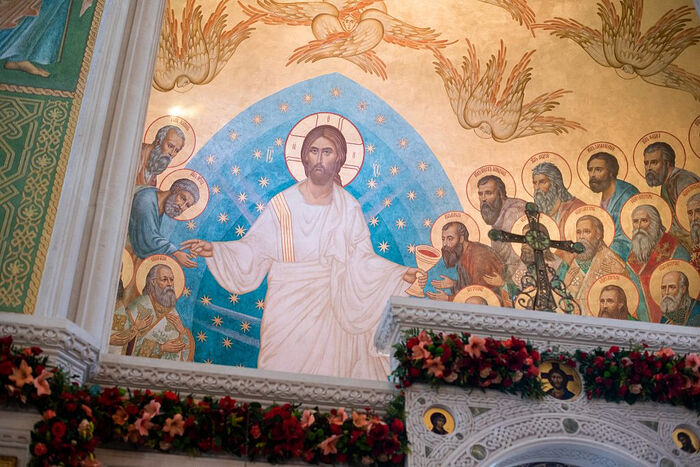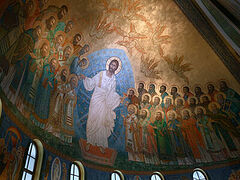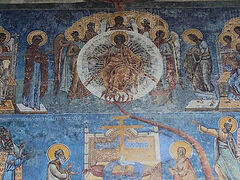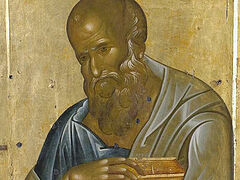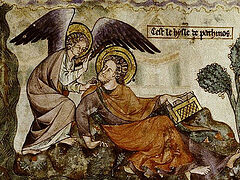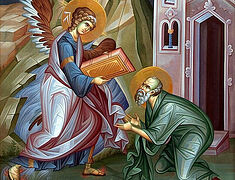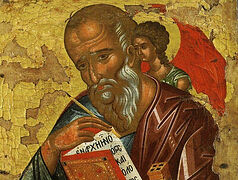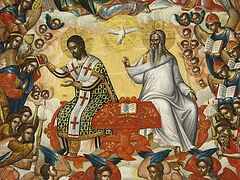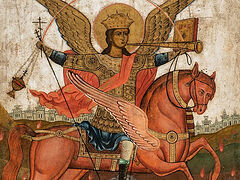Talk 9. About Our Royal Status
 We continue to read the first chapter of Revelation. St. John the Theologian has already greeted the readers of his epistle and conveyed grace and peace to them from the Lord Jesus Christ. After that, St. John exclaims:
We continue to read the first chapter of Revelation. St. John the Theologian has already greeted the readers of his epistle and conveyed grace and peace to them from the Lord Jesus Christ. After that, St. John exclaims:
Behold, He cometh with clouds; and every eye shall see Him, and they also which pierced Him: and all kindreds of the earth shall wail because of Him. Even so, Amen (Rev. 1:7).
The prophetic hymn opens with a word that in the Greek text of the prophetic writings always means that some Divine revelation is about to follow. It can be literally translated as “Look! Here!” and is here translated as “Behold.”
The gaze of the seer [of mysteries] is directed towards the future. He cometh with clouds. As Christ ascended on the clouds, so He will return on the clouds, as the angels told the Apostles on the Mt. of Olives. When returning to earth for the Judgment, Christ will likewise be surrounded by a cloud of His witnesses—the saints and angels.
The phrases, He cometh with clouds, and and every eye shall see Him, and they also which pierced Him: and all kindreds of the earth shall wail because of Him, are based on the coupling of two Old Testament passages:
I saw in the night visions, and, behold, one like the Son of Man came with the clouds of heaven (Dan. 7:13), and:
And I will pour upon the house of David, and upon the inhabitants of Jerusalem, the spirit of grace and of supplications: and they shall look upon Me Whom they have pierced, and they shall mourn for Him, as one mourneth for his only son, and shall be in bitterness for Him, as one that is in bitterness for his firstborn. In that day shall there be a great mourning in Jerusalem, as the mourning of Hadadrimmon in the valley of Megiddon. And the land shall mourn, every family apart (Zech. 12:10-12).
From ancient times, these passages have been understood as prophecies of the Messiah. The Israelite people will “pierce” their Messiah, but on the Day of the Lord, the Anointed One will appear as Judge, and those who pierced Him will “mourn.”
Zechariah goes on to say that In that day there shall be a fountain opened (13:1) that will wash away sin and uncleanness from a repentant people. St. John understands this point differently. Instead of the inhabitants of Jerusalem, he has the kindreds of the earth, who don’t wail at all for the One Who was “pierced.” They behold the Lord with fear and horror on the day of His parousia and weep not so much for Christ as for their own fate on the Day of Judgment. Obviously, St. John here means not only the descendants of the Jews according to the flesh, but also people of other nations who, by their sinful lives, by their rejection of the Gospel, will pierce the Savior a second time. But a terrible moment of clarity will come for them on the Day of Judgment.
St. John also gives this prophecy in his Gospel, describing the events of Golgotha:
For these things were done, that the scripture should be fulfilled, A bone of Him shall not be broken. And again another scripture saith, They shall look on Him Whom they pierced (Jn. 19:36-37).
Before us is a typical prophetic utterance about the judgment over sinful mankind. Let us note how freely the New Testament authors deal with the letter of the Old Testament writings. The Apostles were in the Spirit—thus the “letter” didn’t concern them as much. They could convey this or that Old Testament quote approximately, from memory, or give it a new, unexpected interpretation, or place it in a completely different context. Now our attitude to the “letter” is more scrupulous, but less free and less spiritual.
St. John himself responds to his short hymn with an affirmative exclamation: “Even so.” In the original Greek it reads, “Ναί (Nai),” which means “Yes.” The subsequent “amen” means a reinforced affirmation in an oath, like: “Indeed it is so! So be it!”
Until this point, St. John spoke about God and Christ. Now, Christ Himself speaks, introducing Himself:
I am Alpha and Omega, the Beginning and the Ending, saith the Lord, Which is, and Which was, and Which is to come, the Almighty (Rev. 1:8).
The word about the eternity of God from the fourth verse is repeated here. It should be noted that the formula, “Alpha and Omega, the First and the Last, the Beginning and the Ending” is also used in relation to Christ in other texts of Revelation, for example 1:10, 22:13.
Alpha and omega are the first and last letters of the Greek alphabet. St. Andrew of Caesarea writes:
“Christ is shown here both as God and as the Ruler of all things, both beginningless and at the same endless, existing now and existing before and having no end, since He is coeternal with the Father, and on account of this He will render to each one the wages of deeds done.”1
Tertullian makes an interesting remark:
So, too, the two letters of Greece, the first and the last, the Lord assumes to Himself, as figures of the beginning and end which concur in Himself: So that, just as Alpha rolls on till it reaches Omega, and again Omega rolls back till it reaches Alpha, in the same way He might show that in Himself is both the downward course of the beginning on to the end, and the backward course of the end up to the beginning; so that every economy, ending in Him through whom it began—through the Word of God, that is, Who was made flesh—may have an end correspondent to its beginning. And so truly in Christ are all things recalled to “the beginning”… and lastly, the whole man into Paradise, where he was “from the beginning.”2
Some theologians consider that the eighth verse speaks of God the Father. For example, Lopukhin’s Explanatory Bible says: “The eighth verse speaks of God the Father—the first cause of Divine knowledge.” Fr. Alexander Men sees it the same way.
Interpreting this passage, St. Athanasius the Great recalls the equality of the Father and the Son by nature:
Since They are one and the Divinity is one and the same, then, save for the name of Father, the same is said of the Son as is said of the Father. Thus, for example, the Son is called God—and the Word was God, the Almighty—I am Alpha and Omega, the beginning and the ending, says the Lord; Which is, and Which was, and Which is to come, the Almighty… And you will find many other things, for the Son Himself says: All things that the Father hath are mine (Jn. 16:15), and again: And all Mine are Thine (Jn. 17:10).3
Thus, all our divisions into “Father” and “Son” here are quite conditional. Archimandrite Iannuary (Ivliev) says:
If at first the reader may think that God and Christ have different names: God is called Alpha and Omega, and Christ—the First and the Last, then at the end of the book we see that God expands His name: I am Alpha and Omega, the Beginning and the Ending, and the name of Christ (the First and the Last) is “inserted” into the name of God. Thus, the equivalence of all three names of God is deliberately emphasized. God is eternal in relation to the world; He is the Creator and finisher. But this is also confirmed for Christ. In His essence (and the name always reflects the essence), Jesus Christ is identical to God the Father. St. John thus constructs his theology in this manner that is uncustomary for us.
Or perhaps Christ declares Himself here as if under the new (and moreover, Greek) name “Alpha and Omega” desiring to show that He is the Messiah for all peoples of the Roman Empire, who predominantly spoke and wrote in Greek at that time.
| God | 1:8 | Alpha and Omega | the Beginning and the Ending | |
| Christ | 1:17 | the First and the Last | ||
| God | 21:6 | Alpha and Omega | the Beginning and the Ending | |
| Christ | 22:13 | Alpha and Omega | the First and the Last | the Beginning and the Ending |
The name Alpha and Omega is found in the book exactly seven times (if we consider that “the First and the Last” and “the Beginning and the Ending” are identical to this name). Numerical models have a theological significance in the book of Revelation. Seven is the number of completeness and perfection, and in this case—of Divinity.
It’s interesting that some rabbis call God “the truth,” or “’emet” in Hebrew. This word contains three letters: ‘aleph-mem-tav—the first, middle, and last letters of the Hebrew alphabet, which indicate the eternal nature of God and His dominion at all times. Perhaps the “Alpha and Omega” name for God is also connected with this Jewish tradition.
Christ also calls Himself “the Almighty” (“Pantocrator” in Greek)—He Whose power extends over the entire creation.
We have discussed three of the four most important names for God in the book of Revelation:
-
Alpha and Omega (the First and the Last, the Beginning and the Ending)
-
Which is, Which was, and Which is to come
-
The Lord God… Almighty
We will encounter the fourth name—Him that sat on the throne—beginning with the fourth chapter. We have here God’s first self-declaration in the book. The second place where God gives Himself a name is at the end, in 21:6. These two self-names of God correspond to two analogous self-names of Jesus Christ, in the beginning (1:17) and end of the book (22:13).
With the eighth verse ends the preface to the book of Revelation.
To be continued…

